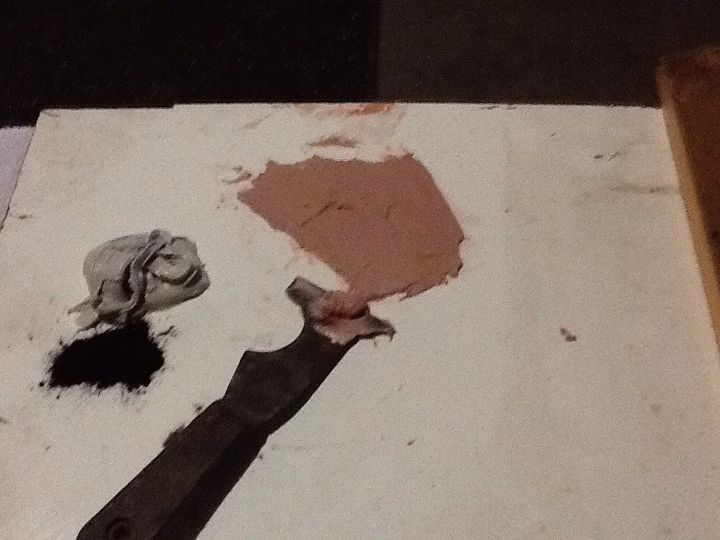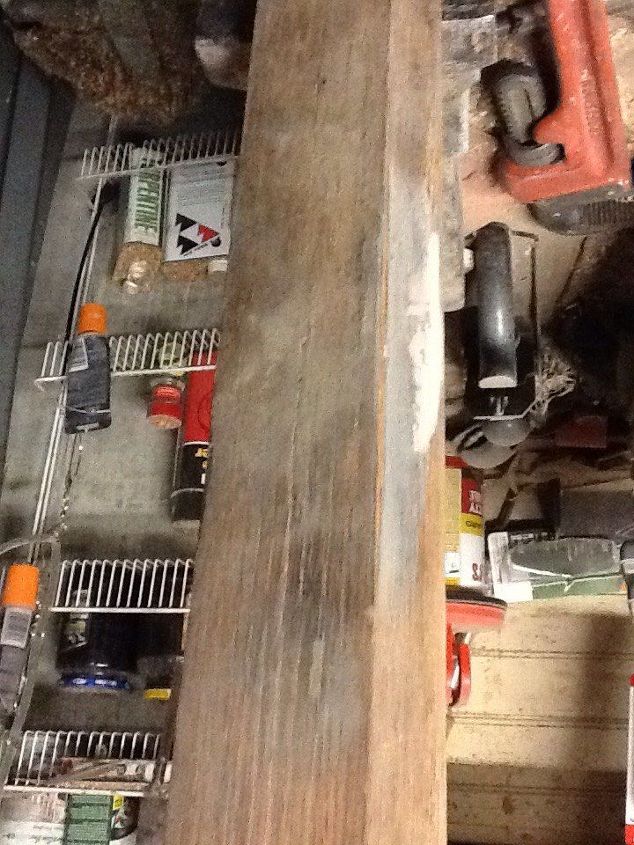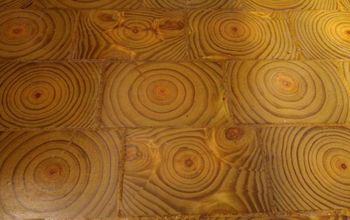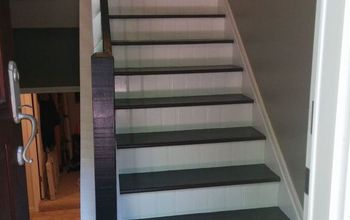Using and Tinting Auto Body Filler for Wood Repair.

I have posted some rustic tables that had defects (knotholes, voids, and hole) that required filling. This posting is a tutorial intended to explain how to use and tint two part auto body filler in your wood projects. There is a host of wood fillers on the market in a variety of colors- they come in tubes and cans and are great for filling small imperfections and nail holes, but none of them have the holding power of two part auto body filler, common brandname Bondo.
If you are going to paint the project you are working on, you can use the filler as it comes- part A which is usually gray or tan and part B (the hardener) that is usually red or white, although I have seen blue. It can be shaped, carved, and sanded to do most repairs.
I deliberately cut a chunk out of a piece of trim and will repair it with un-tinted auto body filler.
The filler comes in a kit ( a quart or gallon) with an appropriate size tube of hardener If you have never used body filler I suggest you view this video. https://www.youtube.com/watch?v=eygKDon4z7M
The technique I like to use is to overfill the defect with excess material and let it start to harden, but before it trully hardens I like to trim it with a putty knife , or a painters knife , or a razor knife and remove most, but not all for the excess. This greatly reduces the amount of sanding required which is the next step, after the filler has completely hardened.
If defects/depressions remain they can be re-work with another treatment of body filler but most ofeten they are so shallow they can be filled with regular wood filler. The very last treatment was done with regular wood filler and sanded.
I have learned how to incorporate cement fillers to tint the filler so that it can be used in projects that are going to be finished naturally, with stain or dyes, and/or varnishes and oils. The repairs will show but look more like characteristic /defects in the wood rather than repairs.
The large container is lampblack that I found on eBay quite a few years ago. I purchased it to tint my body filler. When I learned that it could be used to tint concrete I realized that other concrete tints could be used to tint body filler. I found these NEWLOOK products at Home Depot. They were about $7 for a half pound that should last a long time. I chose a dark brown and a light brown tint. Searching the the internet for concrete pigments will yield other suppliers.
I will now show you how to repair a major defect (a missing knot) in a piece of wood so you can finish it naturally. Find a dowel about the diameter of the missing knot. Cut it at angle so the piece is thinner than the board you are repairing. This step isn’t truly necesssary, but it reduces the amount if filler required and gives “the knot” a solid center.
I started with some part A of the body filler about the size I thought I would need. I usually work in about golf size batches (or multiples thereof) because it will require about a quarter inch squeeze of the harder as it comes from the tube. BEFORE you add the hardener, mix in the cement tint (in this case I used black) with the part A. A little goes a long ways and you can almays add more tint. You can throughly mix in the color and until you add the harder you can work a slowly as you wish or separate it into smaller batches.
Once you add the harder mix very throughly and you have about 5 to 10 minutes working time. I suggest you overfill the holes/defects and scrape it off after it has started to set but not totally hardened. if you scrap out to much, let it harden and refill with another batch. You can actualluy use this technique to create some variation in your repair by repeating with an alternative color.
If this was an actual project I would chisel/chip out some of the black filler and fill with a skim coat of the brown(s) to creat some variation in color, yielding a more realistic looking knot.
This posting could be confusing because I tried to cover tinted and untinted filler in one posting. feel free to ask for clarifications. My cost estimate includes a gallon of Bondo and a pound of tint that will do a lot of repairs. Thanks for viewing,
May 2022. I am not the only person to repair wood with Bondo but using cement tint to color it is an original idea. I did find a you-tube video that discusses using Bondo for wood repair. Hope this adds to the discussion and isn’t against HomeTalk’s policy.
https://www.youtube.com/watch?v=5Zh96B-8pWM










































Frequently asked questions
Have a question about this project?
I’ll definitely remember this! I am wondering.....if you were just using very small amounts of bondo......say for drawer pull holes......could you add a few drops of stain to it before you add the hardener?
Hmm?